Configuration 1: Configuration for creating a highly reliable network of guest domains using GLS on domain-0
NIC switching mode
Make the guest domains (guest OSes) on a single system highly reliable using GLS on domain-0 (host OS). GLS takes the configuration for multiplexing virtual bridges for network redundancy. The following illustrates the configuration.
Figure C.4 NIC switching mode
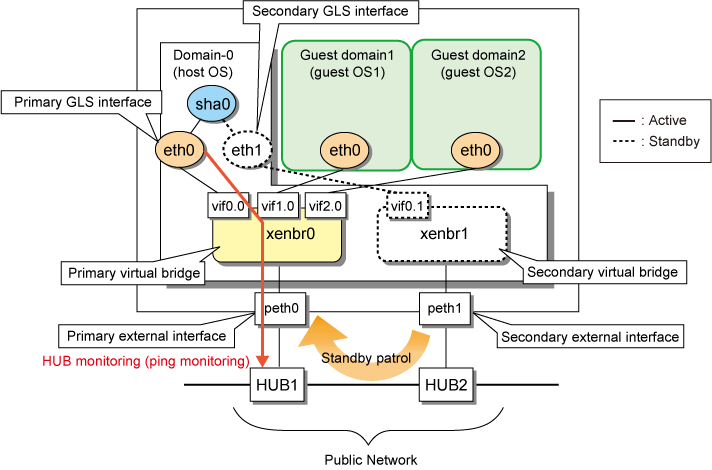
The following describes each component in the figure. Note that the name of a component is defined only in configuration 1.
Name |
| Descriptions |
|---|---|---|
External interface | Primary external interface | An interface connecting the virtual network on the server and the external network. This interface is initially used for operation after the system startup. |
Secondary external interface | An interface connecting the virtual network on the server and the external network. This interface is initially used for standby after the system startup. | |
Virtual bridge | Primary virtual bridge | A bridge connected to a guest OS running applications. This bridge is continuously used for operation. |
Secondary virtual bridge | A bridge used as the path for the monitoring frame of a standby patrol. This bridge is continuously used for standby. | |
GLS interface | Primary GLS interface | An interface for monitoring the transfer route. This bridge is initially used for operation after the system startup. |
Secondary GLS interface | An interface for monitoring the transfer route. This bridge is initially used for standby after the system startup. |
Configure the network as follows to use GLS on the virtual machine function.
The Primary GLS interface and primary external interface are connected to the primary virtual bridge; interfaces of guest domains are connected to the primary virtual bridge.
The secondary GLS interface and secondary external interface are connected to the secondary virtual bridge; interfaces of guest domains are not connected to the secondary virtual bridge.
To set the NIC switching mode for this configuration, see "C.7 Examples of configuration setup (Fast switching mode and NIC switching mode)".
Point
When you create a redundant administrative network or backup network, you need to design the configuration based on the same concept applied when you create a redundant public network.
Virtual NIC mode
Make the guest domains (guest OSes) on a single system highly reliable using GLS on domain-0 (host OS). Setting bridges is required for network redundancy in GLS. Be sure to perform this step. The following illustrates the configuration.
Figure C.5 Virtual NIC mode
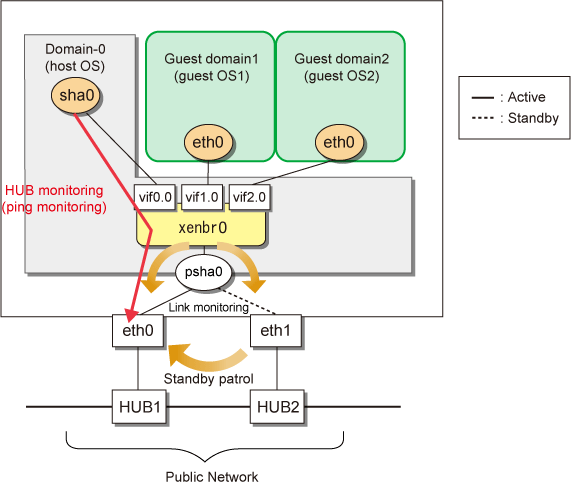
To set the Virtual NIC mode for this configuration, see "C.8 Examples of configuration setup (Virtual NIC mode)".
Configuration 2: Configuration for creating a highly reliable network on guest domains of a single system
Fast switching mode and Virtual NIC mode
When using Fast switching mode
Set the Fast switching mode for the host OS (domain-0) and guest OS (guest domain). See "B.1.1 Example of the Single system" to set the Fast switching mode for the host OS and guest OS.
When using Virtual NIC mode
Set the Virtual NIC mode only for the guest OS (guest domain). See "B.7.1 Example of the Single system" to set the Virtual NIC mode for the guest OS.
Note that GLS multiplexes virtual bridges in order to multiplex NICs. Therefore, you need to set the primary virtual bridge and secondary virtual bridge for the host OS. Be sure to perform this step.
Figure C.6 Fast switching mode and Virtual NIC mode
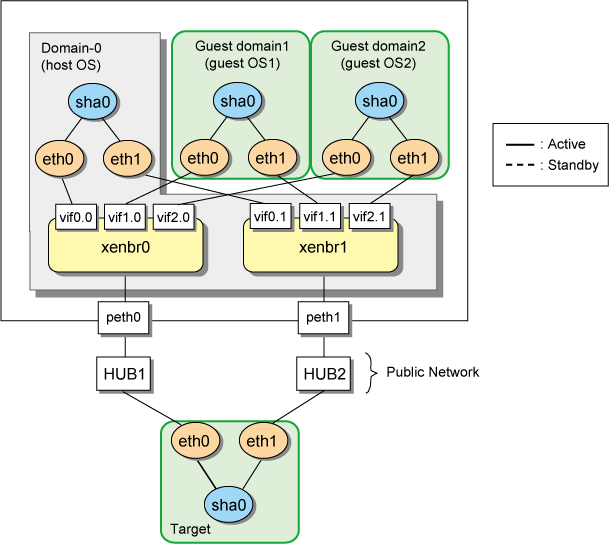
Point
When you create a redundant administrative network or backup network, you need to design the configuration based on the same concept applied when you create a redundant public network.
NIC switching mode
Set the NIC switching mode for the host OS (domain-0) and guest OS (guest domain). See "B.4.1 Example of the Single system without NIC sharing" to set the NIC switching mode for each OS. Note that GLS multiplexes virtual bridges in order to multiplex NICs. Therefore, you need to set the primary virtual bridge and secondary virtual bridge for the host OS. Be sure to perform this step.
Figure C.7 NIC switching mode
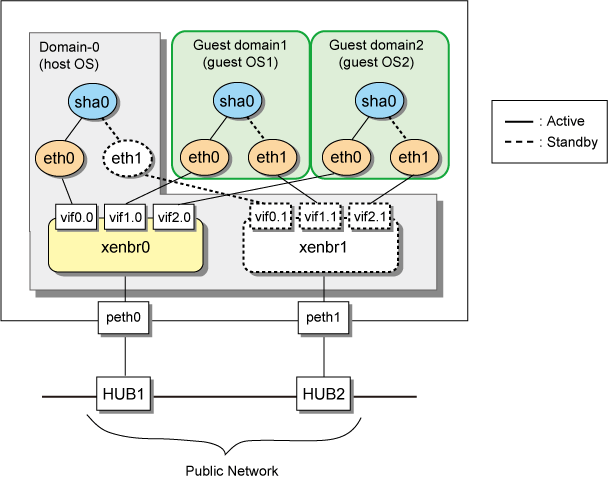
Point
When you create a redundant administrative network or backup network, you need to design the configuration based on the same concept applied when you create a redundant public network.
Configuration 3: Configuration for creating a highly reliable network on each guest domain of a cluster system
Fast switching mode and Virtual NIC mode
The settings for Configuration 2 are applied to each OS (host OS and guest OS). In addition, additional cluster settings are required. See "PRIMECLUSTER Installation/Administration Guide" to perform this step.
Figure C.8 Fast switching mode and Virtual NIC mode
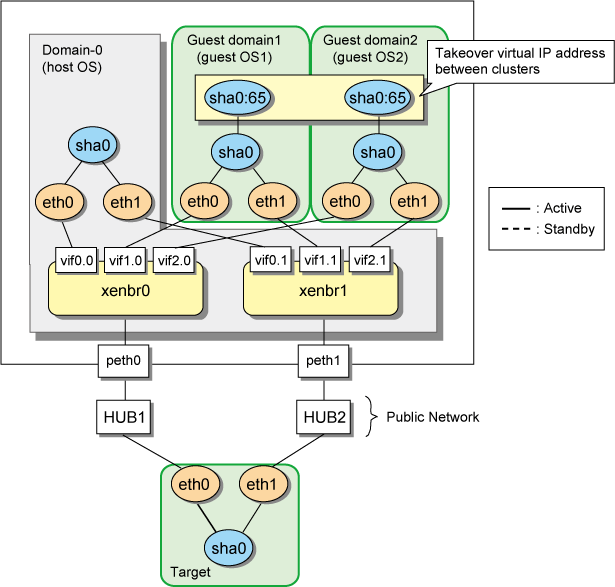
Point
When you create a redundant administrative network or backup network, you need to design the configuration based on the same concept applied when you create a redundant public network.
NIC switching mode
The settings for Configuration 2 are applied to each OS (host OS and guest OS). In addition, additional cluster settings are required. See "PRIMECLUSTER Installation/Administration Guide" to perform this step.
Figure C.9 NIC switching mode
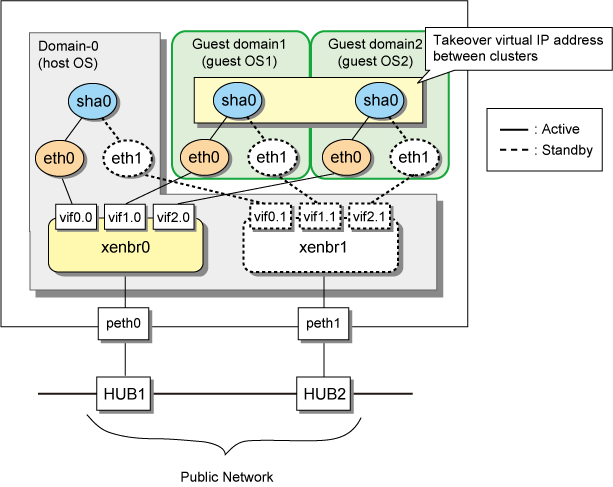
Point
When you create a redundant administrative network or backup network, you need to design the configuration based on the same concept applied when you create a redundant public network.